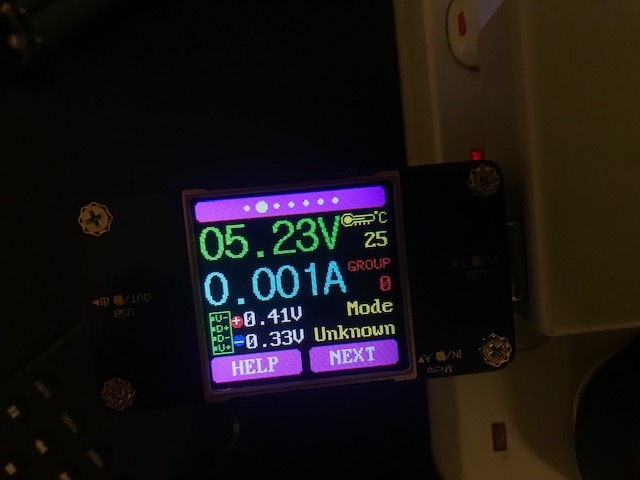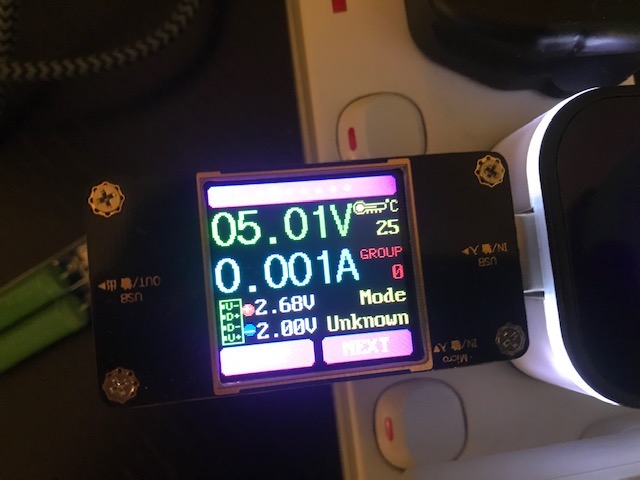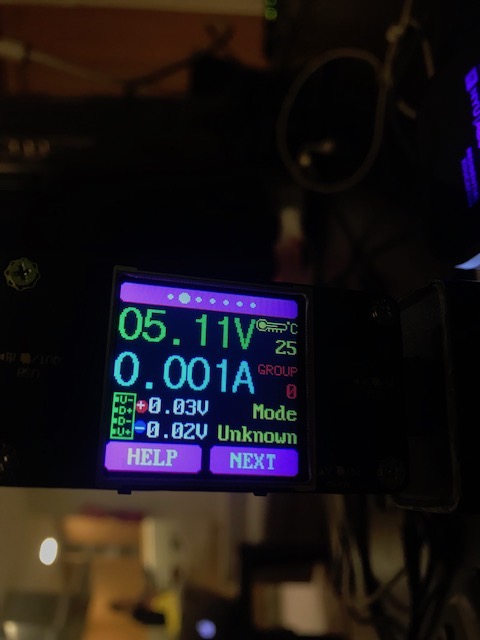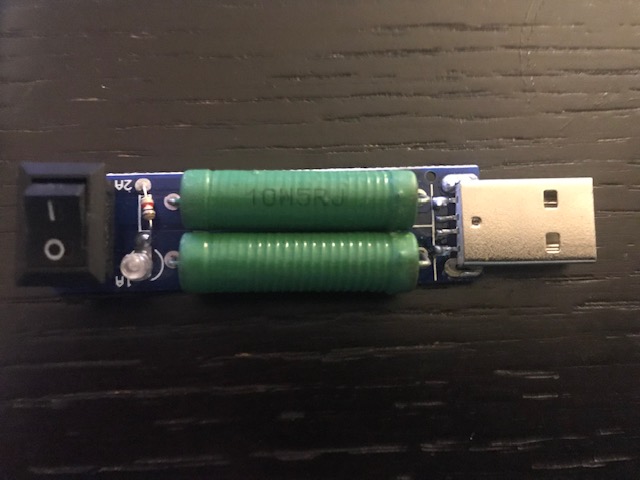Topic
Testing Electronics with USB Ammeter/Voltmeter
Forum Posting
A Membership is required to post in the forums. Login or become a member to post in the member forums!
Home › Forums › Gear Forums › Gear (General) › Testing Electronics with USB Ammeter/Voltmeter
- This topic has 2 replies, 3 voices, and was last updated 6 years, 2 months ago by
 Bob Shuff.
Bob Shuff.
-
AuthorPosts
-
Oct 17, 2018 at 4:48 pm #3560240
Hello! Because I like to overthink things, I bought an in-line USB voltmeter/ammeter at the recommendation of David Thomas to test out batteries, cords and wall chargers. Unfortunately, these don’t come with instruction manuals. A few questions for the experts:
First, I’m confused about one of the readings. I plugged three different wall chargers into the wall, and the ammeter into each one. I got the following readings:



What are / how do I interpret the values next to the blue “+” sign and the red “-” sign (the first is +0.41V/-0.33V, the second is +2.68V/-2.00V, and the third is +0.3v/-0.2V)? Is this useful information / does it tell me anything about the quality of the chargers?
I bought this little device to provide a constant draw, which lets me switch between 1A and 2A. This tells me if a wall charger is even capable of 2A output just by setting up wall + charger + ammeter + load tester.

I also bought this Fonken 18W charger (https://www.amazon.com/FONKEN-Charger-Compatible-Qualcomm-Certified/dp/B01MATI1EJ/ref=sr_1_1?s=wireless&ie=UTF8&qid=1539794104&sr=1-1&keywords=fonken%2B18w&th=1) and curiously while it charges my Powercore II at 2A, it will not output more than 1A when I plug my iPhone directly into the Fonken charger. I know my iPhone isn’t capable of QC, but I thought it would at least draw 2A given that it’s an 18W charger. I’ve ordered an iClever boost cube, which weighs more, but has two ports; hopefully that will do the trick.
Last questions:
If I want to test the actual capacity of my power bank, I would just fully charge it and then let it drain fully using my load tester? The ammeter I think will record mAh output.
Any other measurements of concern / any other uses for my new toys?
Thanks,
Oct 17, 2018 at 5:21 pm #3560244“If I want to test the actual capacity of my power bank, I would just fully charge it and then let it drain fully using my load tester?”
Yes. Should retain data (until reset) so when plugged in to new power source will display results.
Be sure to fully charge your power bank. On many units that last fourth light means “charging the last quarter”, or somesuch, not “fully charged”.
Oct 17, 2018 at 5:28 pm #3560245Hi John,
A few comments/questions.
- Are the V/A meters plugged in to a load, i.e. battery or phone? If not, then install the load first before worrying about any of the readings. Although open circuit voltage and closed circuit current are referenced in EE discussions, I don’t think they are relevant to a quick analysis of how well a charger/battery works. I don’t know what the +/- reflects for sure, but would guess it captures how the voltage varies during the charge. I would not consider this too important, although it might weed out defective supplies or supplies that are under powered. I believe the batteries should all USB power bricks will charge with a constant voltage.
- The voltage can change with the new QC and other proprietary charge methodologies. It can vary the voltage to specific steps in some algorithms or vary infinitely to maximize the charge with newer technologies. Note that the decision on voltage and current is decided by the power brick or phone when plugged into the wall socket. It is more collaborative when the phone is plugged into the power brick. For backpacking, I think charging the brick quickly from AC is the main concern. You can plug your phone into the brick in your pack or in your tent overnight to top that off over a longer period of time. It’s great to have the meters to see what combination works best.
- I’ve had good luck with RavPower QC3 chargers and bricks, and have seen 9V, 2A on a similar meter – that’s how many of these supplies will achieve 18W. It’s not surprising that QC3 charger to non-QC3 bricks might not achieve the maximum power. The powercore ii, I think uses PowerIQ 2.0 (up to 18W Output), so you might look for an Anchor charger that supports PowerIQ if not satisfied with the current combo’s rate.
- When charging the phone (from AC supply or brick), again it’s up to the phone. I haven’t tested this as much because I’m not worried about how long it takes.
Overthinking only get’s you so far. Looks like you need to start overtesting my friend. The load should work to drain bricks for more testing, but it probably won’t negotiate maximum charge rates like a phone or brick would. Also, I don’t like to drain my phone or bricks too much. It might take a lot of discharges, but eventually, you will reduce the battery life of the product by draining it too much. There is a limit – even if it seems like it’s years away.
-
AuthorPosts
- You must be logged in to reply to this topic.
Forum Posting
A Membership is required to post in the forums. Login or become a member to post in the member forums!
Our Community Posts are Moderated
Backpacking Light community posts are moderated and here to foster helpful and positive discussions about lightweight backpacking. Please be mindful of our values and boundaries and review our Community Guidelines prior to posting.
Get the Newsletter
Gear Research & Discovery Tools
- Browse our curated Gear Shop
- See the latest Gear Deals and Sales
- Our Recommendations
- Search for Gear on Sale with the Gear Finder
- Used Gear Swap
- Member Gear Reviews and BPL Gear Review Articles
- Browse by Gear Type or Brand.






